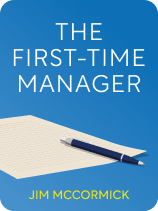

This article is an excerpt from the Shortform book guide to "The First-Time Manager" by Jim McCormick. Shortform has the world's best summaries and analyses of books you should be reading.
Like this article? Sign up for a free trial here.
Do your employees struggle when working together? How can you build an effective team?
The First-Time Manager by Jim McCormick argues that the most important task of a manager is recruiting and maintaining a team of strong and effective individuals. He discusses how to hire and train the right people, evaluate their performance and give feedback, and empower your team to take initiative.
Keep reading to learn how to build an effective team.
1. Hire New Employees
First, to learn how to build an effective team, you must hire the right people and train them to succeed in their roles. Bad hiring decisions can cost you time and money, while hiring the right person can add immense value to your team. Let’s look at some tips for identifying, selecting, and training the right candidates.
Identify and Interview Prospective Employees
To attract the right candidates, write a clear and effective job description. McCormick suggests that it cover three types of requirements: First, specify the knowledge and technical skills required for the job. Second, explain the behavioral qualities you’re looking for, such as being punctual. Third, lay out interpersonal requirements important for the job, such as accepting feedback positively.
Once you have prospective candidates to interview, McCormicks recommends you prioritize attitude over qualifications. He argues that an employee with a good attitude is more valuable than a better-qualified employee with a bad attitude. When interviewing your candidate, ask questions assessing attitude—for example, “What’s your ideal workday like?” Specifically, you should look for traits like commitment and good judgment as opposed to interest in social activities or holidays.
Train New Hires
Once you’ve selected a candidate, the next step is to train them to perform well in their role. McCormick suggests you find a good trainer to effectively train new hires. This should be someone who can clearly explain each responsibility and break down the job into smaller pieces so that the new hire doesn’t get overwhelmed. McCormick cautions against assigning a person who’s leaving or was recently fired from the role to train new employees because they won’t provide quality training. Once you have a trainer in mind, meet with them and discuss a training plan.
Next, spend the first day helping the new hire familiarize themselves with their new work environment. Take this time to clearly communicate your expectations—for instance, that you value attitude and continuous improvement. Provide them with support so that they can meet your standards and don’t expect perfection from them—this will prevent them from feeling overwhelmed.
2. Manage Your Team’s Performance
To build a strong team, manage your employees’ performance by providing regular feedback, conducting periodic performance reviews, and enforcing discipline when appropriate. These techniques will help you enhance their overall productivity while helping them improve their skills and achieve their goals.
Give Regular Feedback
According to McCormick, a good manager makes sure their employees know how well they’re performing by providing feedback on a regular, ongoing basis. There are two types of feedback you can give: praise to encourage positive behavior and constructive criticism to help someone improve their behavior or performance.
When giving praise, describe in detail the work or behavior you’re praising. This helps people understand what behaviors you’re looking for and makes them more likely to behave similarly in the future. Also, describe the positive outcome that resulted from their actions because people enjoy feeling like they’re contributing to something greater.
When giving constructive criticism, McCormick recommends you focus on addressing the behavior and not judging the person, which degrades people’s confidence and performance. Treat the behavior as a misunderstanding, ask for their input instead of doing all the talking, and give this criticism in private, such as in your office, so people feel less embarrassed.
Conduct Performance Reviews
In addition to having informal feedback conversations, McCormick advises that you also conduct formal performance reviews once or twice a year to improve your team’s performance. These are periodic evaluations of each employee’s work that let them know how well they’re meeting expectations and how they can improve. According to McCormick, employees often want more feedback than many managers may assume.
McCormick adds that you should be fair, honest, and objective when conducting performance reviews. Avoid rating every team member as satisfactory or above. This may be tempting to do, but giving inaccurate ratings deprives employees of the opportunity to grow and improve.
Resolve Work Problems and Enforce Discipline
You’ll also need to know how to resolve work problems and take disciplinary actions when appropriate. This ensures your team maintains high standards and people are fairly rewarded for their efforts.
If you experience behavioral or performance problems with an employee, McCormick suggests you create a performance improvement plan. You can make one by dividing a sheet of paper into three sections—strengths, areas of improvement, and goals. Then, work with your employee to fill out each section and decide on a time frame for the goals.
You may need to occasionally dismiss an employee. Before you fire a worker, McCormick suggests you consider all possible alternatives, such as giving them additional training. However, while firing people can be hard, it’s often beneficial for the employee—they’ll likely be thankful to be in a position that better suits their strengths. Before dismissing someone, McCormick suggests you check that you have their performance or behavior documented to avoid potential lawsuits.
3. Empower Your Team to Innovate and Take Initiative
McCormick writes that you can nurture a high-performing team by empowering your employees to be innovative and to make independent decisions. He explains that technology has made centralized decision-making outdated and ineffective. As a result, teams that can operate with self-efficacy will be better able to keep up with the fast pace of business.
Know What Kind of Support Your Employees Need
To empower your team members, first figure out what kind of support they need from you. Different employees need different amounts of control and encouragement from you to function at their best. Assess the support your employees need based on two things: motivation and skill level.
First, evaluate how much motivation your employee has. This helps you determine how much encouragement they need from you. A highly motivated employee needs little encouragement while an unmotivated employee needs a lot of encouragement.
Second, assess the level of their knowledge and skills. This helps you determine how much oversight and control you should exercise—for example, how detailed your instructions should be or how often you should check in on their work. The more knowledgeable and skilled an employee is, the less control they require to perform well.
Build Your Team’s Confidence
McCormick writes that you can also empower your team by finding ways to boost their confidence so they feel capable of taking initiative and making decisions on their own.
One way to boost your team’s confidence is to provide them with little victories. You can do this by first assigning tasks that are relatively easy and within their capabilities. That way, they can achieve good results and feel more confident about their skills and their work.
Another way to increase your team’s confidence is to encourage employees to make decisions on their own. To do this, react to mistakes productively and don’t expect perfect decisions. People who fear making the wrong decision won’t make any at all, and if you harshly criticize those who do take initiative, you’ll only discourage them from trying. If someone makes a flawed decision, review the situation, discuss what could be done better next time, and thank them for taking the initiative.
4. Motivate Your Employees
To run an empowered team, you also need to keep your employees motivated. To do this, figure out what drives them individually—what keeps them engaged in their work and pushes them to perform well. McCormick recommends several ways to motivate your employees:
Method #1: Align individual and company goals. Motivation varies from person to person, so McCormick recommends getting to know your employees’ goals, whether they’re interested in learning a new skill or networking with more people. To inspire them to do their best work, try to match their goals with those of the company—for instance, if they want to learn a particular skill, offer them training or mentorship opportunities.
Method #2: Share positive outcomes. People enjoy contributing to something bigger than themselves. Showing how their efforts contribute to a positive outcome gives their work more meaning and motivates them to work hard.
Method #3: Give rewards. Rewards show people that their performance and efforts matter and are therefore a great motivator for employees. You should not only reward successful endeavors, McCormick writes, but also thoughtful and well-executed ones that don’t succeed. This encourages people to take innovative risks instead of playing it safe to avoid failure.

———End of Preview———
Like what you just read? Read the rest of the world's best book summary and analysis of Jim McCormick's "The First-Time Manager" at Shortform.
Here's what you'll find in our full The First-Time Manager summary:
- How to succeed as a manager, whether it's your first time or not
- Why managers should shift their focus from tasks to people
- How to gain the trust of your employees and empower them to take initiative






